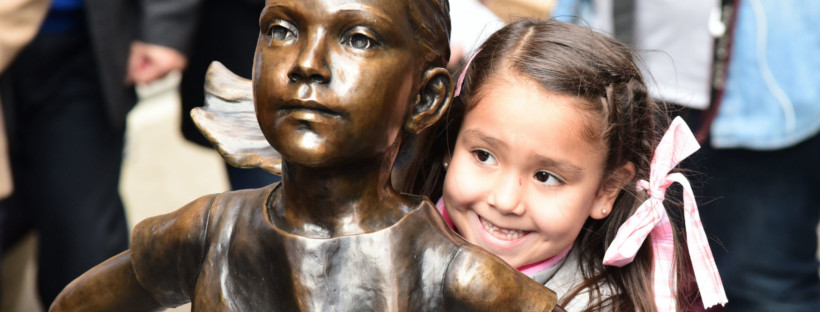Historical Representation and Visualization: Critical for Aspiring Young Girls and Women

Statues and monuments have been erected throughout human history. Be they real people who led important lives or mythic or fantastical figures, these artistic depictions dot our world—our museums, our parks, and other public spaces—and help us visualize our shared history and heritage.
The present state of our historical public art is worth considering as the world celebrates International Women’s Day. Each year, March 8 is a global day celebrating the social, economic, cultural, and political achievements of women—roles that are not proportionally reflected among the historical statue and monument catalog.
Consider New York City, which has recently been in the spotlight about this subject. While best known for the Statue of Liberty, just five of the city’s 150 historical statues and monuments depict women and their real-world accomplishments. There are exactly zero historical statues of women in Central Park. Sure, there are female figures—angels, fictional characters—but none celebrating the very real and historical triumphs of women.
This omission of real women being represented by statues is not unique to New York City. Across North America, of all the statues honoring real people, less than eight percent depict women. Washington, D.C., a city filled with monuments to the past, has only 13 female statues, compared to 147 representing prominent men in history. In California, San Francisco has 84 statues of historical men but just three that are women. The cities of Boston, Atlanta, and Columbus each have just one. In Toronto, public art depicting inspiring women make up less than one percent of the city’s 200 public pieces.
Representation among statues and monuments is important, because these public artworks help our society visualize our shared history. They depict moments and people we agree are important, impactful, and worth remembering—and it’s critical to make women a more equal part of that experience.
For young girls particularly, seeing examples of real women succeeding—in both the present and the past—is critical for developing confidence, leadership, aspirations, and other attributes that help them learn, grow, and make meaningful impacts on the world around them. Girls need fearless, visible role models starting from a very young age, to foster greater awareness of the possibilities in their own lives and help set them on their own brilliant paths. Seeing it is critical to being it, and to making history themselves.
In our work at the National Coalition of Girls’ Schools (NCGS), we have seen and experienced the impact of role models. At girls’ schools, students are regularly exposed to older peers who are succeeding in all types of class work and extracurricular activities. They see older classmates taking on new challenges—and when they see it happening, they know they can accomplish similar, great things. Upon graduation, students see themselves and their peers receive tremendous accolades, all of them women. Alumnae who return and contribute their time and talent to the schools’ future are women serving as role models for current students.
In New York City, there is important work being done toward making the historical monument landscape more equal. This year, the organization Monumental Women is set to meet its goal of “breaking the bronze ceiling,” and will unveil the first statue of real women in Central Park’s history. Sculpted by Meredith Bergmann, the monument depicts three pioneers of women’s rights: Sojourner Truth, Susan B. Anthony, and Elizabeth Cady Stanton, a graduate of Troy Female Seminary, now known as Emma Willard School, a member of NCGS.
The unveiling is scheduled to take place on August 26, 2020—the 100th anniversary of the ratification of the 19thamendment, which prohibited the states and federal government from denying women their right to vote. This was no doubt a watershed moment in women’s history in the U.S., and it’s essential to remember the suffrage movement was ongoing for years afterward—it wasn’t until even later, in the 1960s, that women of color were able to freely exercise that right in the U.S.
It’s a reminder that women’s history is an ongoing story. In 2020, the average number of women serving in major governing bodies worldwide is still just 24 percent. While girls’ school graduates such as Sen. Shelley Moore Capito (R-WV); Rep. Jackie Speier (D-CA); Christine Todd Whitman, first woman elected governor of New Jersey; Condoleezza Rice, 66th U.S. Secretary of State; Susan Rice, former U.S. Ambassador to the United Nations; Rep. Nancy Pelosi (D-CA), first woman to serve as the Speaker of the U.S. House of Representatives; The Hon. Carolyn Bennett, who serves on the Canadian Prime Minister’s Cabinet as the Minister of Crown-Indigenous Relations; and the leader of the women’s suffrage movement in Quebec, Thérèse Casgrain, who was appointed by Prime Minister Pierre Trudeau to the Senate of Canada, blazed trails and continue to serve as role models for the next generation of female leaders, there is still much work to be done.
Creating greater equity and a more just society for women will require new generations of female leaders—leaders who have seen and experienced a public life where historic women leaders are placed on equal footing with men.
Megan Murphy, Executive Director, National Coalition of Girls’ Schools
Related tags: Developing Girls as Leaders, Global Leaders, International Women's Day, Leadership, Peer Role Models, Political Voice, Role Models, See It To Be It, Women in Politics, Women's History, Women's History Month